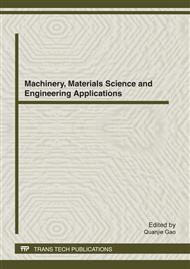p.536
p.541
p.545
p.549
p.555
p.559
p.563
p.569
p.575
Study of Synthesis Process of L-Ascorbic Acid Cellulose Ester
Abstract:
In this article, L-ascorbic acid cellulose ester, a polymer with antioxidant properties, was synthesized using L-ascorbic acid and sodium carboxymethyl cellulose as feedstock. The whole reaction was divided into two parts: the preparation of carboxymethyl cellulose carbonyl chlorides and the synthesis of L-ascorbic acid cellulose ester. The optimal conditions of acyl chloride preparation: ratio (m/v) of CMCH to SOCl2 was 1:3, proportion (m/v) of CMCH to DMF was 1:20, reaction temperature was 110-120°C, reaction time was 2h. The optimal conditions of L-ascorbic acid cellulose ester synthesis: ratio (m/v) of L-ascorbic acid to solvent was 1:3.5, proportion (Mol/Mol) of Carboxymethyl cellulose carbonyl chlorides to L-ascorbic acid was 1:1.3, reaction temperature was 20°C, reaction time was 22h. In this reaction conditions, the synthetic product not only saved the antioxidant activity of the groups, and added the safe and non-toxic ability of dietary fiber.
Info:
Periodical:
Pages:
555-558
Citation:
Online since:
April 2012
Authors:
Keywords:
Price:
Сopyright:
© 2012 Trans Tech Publications Ltd. All Rights Reserved
Share:
Citation:


